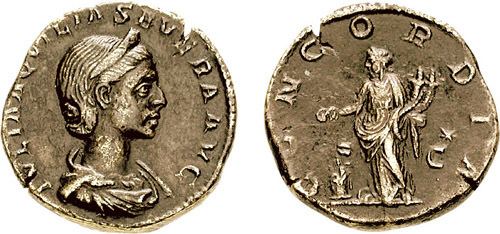 | ||
In ancient Roman religion, Concordia is the goddess who embodies agreement in marriage and society. Her Greek equivalent is usually regarded as Harmonia, with musical harmony a metaphor for an ideal of social concord or entente in the political discourse of the Republican era. She was thus often associated with Pax ("Peace") in representing a stable society. As such, she is more closely related to the Greek concept of homonoia (likemindedness), which was also represented by a goddess.
Contents
Concordia Augusta was cultivated in the context of Imperial cult. Dedicatory inscriptions to her, on behalf of emperors and members of the imperial family, were common.
In art
In art, Concordia was depicted sitting, wearing a long cloak and holding onto a patera (sacrificial bowl), a cornucopia (symbol of prosperity), or a caduceus (symbol of peace). She was often shown in between two other figures, such as standing between two members of the Imperial family shaking hands. She was associated with a pair of female deities, such as Pax and Salus, or Securitas and Fortuna. She was also paired with Hercules and Mercury, representing "Security and Luck" respectively.
Temples
The oldest Temple of Concord, built in 367 BC by Marcus Furius Camillus, stood on the Roman Forum. Other temples and shrines in Rome dedicated to Concordia were largely geographically related to the main temple, and included (in date order):
In Pompeii, the high priestess Eumachia dedicated a building to Concordia Augusta.
Modern religion
Harmonians and some Discordians equate Concordia with Aneris. Her opposite is thus Discordia, or the Greek Eris.
Namesakes
The asteroid 58 Concordia is named after her.
